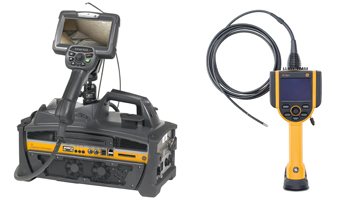AMU Chronicles: Borescopes
Not So Boring – Borescopes
A large part of our job maintaining aircraft is the never-ending task of routine inspections. As an example, turbine engine hot section inspections quickly become lukewarm after tedious repetition. Of course, the need for these inspections is elementary. The hottest running components of any gas turbine engine must work in the engine’s harshest internal environments, so of course these are inspected regularly to determine the engine’s health. Turbine blades and nozzle guide vanes, along with combustion can liners, are the parts most likely to fail first, and are most vulnerable to extreme temperature anomalies. Ideally, by keeping a close eye on these components, usually by borescope, we can utilize early detection to catch a minor problem long before a potentially catastrophic engine failure occurs in flight.
One of the great advantages of attending the annual Ontario AME Workshop and Symposium is always the excellent selection of seminars to attend. This year’s show was no exception, with lots of new and innovative equipment on display to dazzle even the most jaded AMEs among us.
My favorite seminar this year was the latest technology in 3D measuring borescopes hosted by Bill Tarant, General Electric’s Sales Representative for Inspection Technologies. After a brief but entertaining overview of this tool’s history, he proceeded to dazzle us with a demonstration of the latest technology in three-dimensional borescope techniques.
Perhaps I was easily impressed, having been out of active industry service for a while. In fact, many reading this may already be using this technology. In my opinion, the applications of fiber optics, lasers and computer software have been combined in such a way as to make this latest inspection tool quite revolutionary.
Backtracking through my personal aviation career, I thought it was pretty cool when you could do a borescope inspection and create a color video of what you viewed (originally by VHS tape, and eventually through digital technology). By doing so, you could expand your experience base, making judgment calls by sharing this information with others in the industry. Engine manufacturers, overhaul shops and other knowledgeable resources could then help you decide if that engine should continue in service or be pulled for overhaul.Good information to have when cracks appear, and it’s your signature on the line.
With 3-D borescopes much of the guesswork has been removed. Any doubts about whether you are looking at carbon streaking or shadows is instantly removed. It has the ability to measure defects, such as cracks, very accurately using laser technology for length, width and depth. It can photograph this information with pinpoint dimensions and can also create a rotating three-dimensional cloud view with superimposed dimensions that can be sent via email or transferred to a stick as a simple jpeg file. Assuming you have clear-cut parameters to make your judgment call and a laptop, your job has just become a lot easier. It can also be efficiently recorded and stored with the click of a mouse. It doesn’t get much better than that. For an interesting and informative demonstration, contact Bill Tarant at GE (bill.tarant@ge.com).
Email Bill Tarant
The other lesson you should take from this column is to get out there and see what all the AME and PAMA associations have to offer at various workshops and tradeshows all over North America. It is well worth the effort. Besides being a great social and networking opportunity, you may actually enjoy seeing what new technology is out there waiting for you. In addition, you will be supporting the associations that work so hard on behalf of all aircraft technicians.
Since I have launched into the topic of tradeshows, it gave me great pleasure to present Bill Carter and AMU Magazine the Clare Leavens Award for 2012 at our Ontario AME Association banquet this past October. To loosely quote my presentation speech: In its 10-year history, AMU Magazine has done a great deal to mentor and support AME and PAMA Associations all over North America while simultaneously bringing us all a little closer together. It has provided a respected venue for our newsletters and has always provided topical and interesting articles about our industry. In short, it gives a voice and presence to all aircraft technicians across North America.
The Clare Leavens Award is presented in memory of one of the three founding brothers of Leavens Aviation in Canada. To quote the selection criteria, “the award is given to a Member of the Aircraft Maintenance Engineers Association of Ontario who, in the opinion of the directors and members, has made a particularly outstanding contribution to the continued success of the association.” In my opinion, AMU Magazine has exceeded that criteria and is a very worthy recipient of this award. Congratulations to Bill, Ian and the entire crew at AMU.
As for the guy on the cover, all I can say is thank you all very much. Receiving the Aviall High Achievement Award is one of the true benchmarks of my career and I will never forget it. There truly is no greater personal achievement than to be honored and acclaimed by your peers.
For more published writing by Sam Longo, please visit www.samlongo.com
About The Author
Sam enjoys life in Toronto, Ontario. For more published writing by Sam Longo, please visit www.samlongo.com
View all articles by Sam Longo.
















































Leave a Reply
You must be logged in to post a comment.